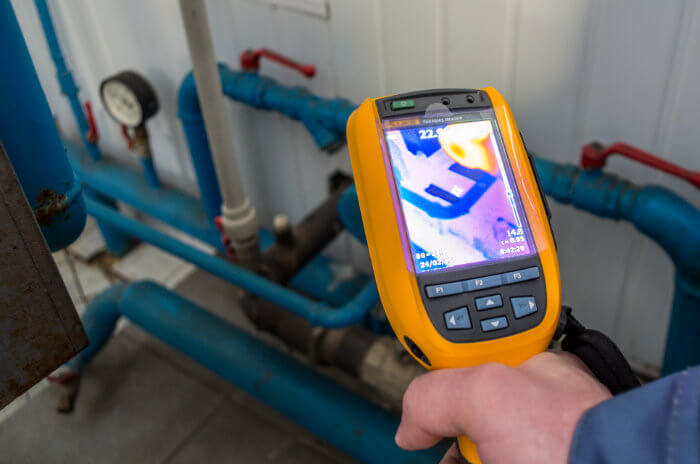Why Timely Water Leak Detection is Crucial for Preserving a Healthy And Balanced Home
Cutting-edge Solutions for Very Early Detection of Water Leaks in Buildings and Infrastructure
As the honesty of buildings and facilities is critical, the challenge of very early detection of water leaks has spurred innovative services that promise to revolutionize the method we guard against prospective damages. From advanced leakage discovery modern technologies to the implementation of IoT sensors for real-time monitoring, the landscape of leak prevention is developing rapidly. Artificial intelligence formulas offer a glance into the future of leak forecast, while thermal imaging offers a non-intrusive method for identifying surprise leakages. Automated water circulation analysis systems are reshaping exactly how leakages are recognized and dealt with, leading the way for a proactive approach to water leakage detection. Each of these solutions holds the vital to ensuring the integrity and longevity of our constructed environment, triggering a change towards a more sustainable and reliable future.
Advanced Leakage Detection Technologies
Advanced leak discovery modern technologies, furnished with advanced sensing units and algorithms, play an essential duty in swiftly recognizing and identifying water leakages in different setups. Electromagnetic sensing units can identify changes in electromagnetic areas created by water, supplying yet an additional layer of leakage detection ability.

IoT Sensors for Real-Time Tracking
In the world of modern-day water leak detection, the assimilation of IoT sensors for real-time tracking represents a crucial development in boosting positive leakage discovery capacities. These sensing units provide continual monitoring of water supply, offering real-time data on water circulation prices, pressure variations, and temperature level changes. By leveraging IoT innovation, these sensors can find even the tiniest abnormalities in water usage patterns, allowing early identification of prospective leakages before they escalate right into major concerns.
IoT sensors transfer information to a centralized platform, where advanced formulas evaluate the details and generate alerts or notices when irregularities are detected. This real-time monitoring ability allows homeowner or center supervisors to quickly resolve leakages, decreasing water damage, minimizing repair work costs, and conserving water sources.
Moreover, IoT sensors can be integrated with structure management systems, enabling for computerized responses to identified leaks, such as turning off water shutoffs or activating pumps to mitigate the influence of leaks. Overall, the execution of IoT sensors for real-time monitoring dramatically improves the efficiency and performance of water leak detection view in structures and infrastructure.
Artificial Intelligence Algorithms for Leakage Prediction

One trick benefit of utilizing machine understanding for leakage prediction is its capacity to continually find out and enhance its accuracy with time. As more data is gathered and fed into the formula, it can fine-tune its forecasts and adapt to transforming conditions, inevitably raising the dependability of leakage discovery systems.
Furthermore, artificial intelligence formulas can assist in identifying refined indications of leakages that may go undetected by conventional tracking methods. water leak detection. By analyzing complicated information sets in real-time, these algorithms can supply very early warnings and signals, enabling prompt intervention and preventive maintenance to alleviate possible water damages and associated expenses
Utilizing Thermal Imaging for Leak Discovery
Thermal imaging technology uses an appealing approach for identifying water leaks in different systems and frameworks. By utilizing infrared radiation and temperature variations, thermal imaging cameras can determine surprise leaks that are not easily noticeable to the nude eye. When water escapes from pipes or frameworks, it frequently alters the temperature level of the surrounding area, producing temperature level differentials that thermal cameras can catch. These temperature level irregularities are after that converted into visible photos, highlighting the specific area of the leak.
One of the vital benefits of thermal imaging for leakage discovery is its non-intrusive nature. Unlike standard approaches that might need damaging right into wall surfaces or floors to find leaks, thermal imaging enables for non-destructive testing. This not only conserves time and reduces Click Here prices yet additionally decreases interruption to the building or infrastructure being evaluated. Furthermore, thermal imaging can rapidly scan huge locations, offering a detailed summary of potential leak resources in a prompt way. In general, making use of thermal imaging technology boosts the performance and accuracy of water leak discovery, making it a valuable tool for keeping the stability of buildings and frameworks.
Automated Water Circulation Analysis Equipments
Exactly how can computerized water circulation evaluation systems reinvent the detection and administration of leaks in different my link systems and infrastructures? Automated water circulation analysis systems use a proactive strategy to leak detection by continually monitoring water flow prices and patterns. By establishing standard information, these systems can rapidly recognize deviations that might show a leak, allowing punctual intervention to stop extensive damages.
These systems make use of advanced formulas to assess real-time data and supply prompt alerts when anomalies are detected, enabling for quick activity to be taken. Additionally, automatic water circulation evaluation systems can be incorporated with building administration systems or IoT systems, boosting overall efficiency and allowing remote tracking capacities.
Furthermore, the information accumulated by these systems can be utilized for anticipating upkeep functions, helping to identify prospective weak factors in the facilities before leaks occur. Overall, the implementation of automated water circulation evaluation systems can considerably boost leakage discovery and monitoring methods, eventually causing set you back savings, decreased water wastage, and increased sustainability in structures and framework.

Verdict
To conclude, the assimilation of advanced leakage detection innovations, IoT sensing units, equipment understanding formulas, thermal imaging, and automatic water flow analysis systems provides ingenious services for early detection of water leaks in structures and framework. These technologies allow real-time tracking, prediction of leaks, and reliable discovery approaches to avoid water damages and waste. Executing these remedies can aid in keeping the stability and sustainability of water systems in various setups.